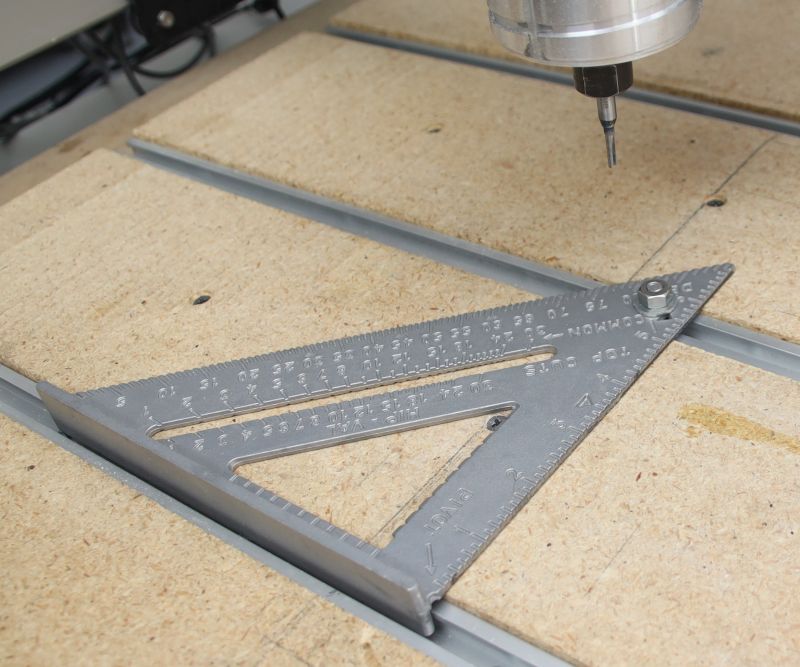This may be old news to those of you who have been around a CNC for a while, but the idea of using a speed square for a rock solid, self-aligning, low-clearance, work-holding stop on the waste board T-track just came to me. This worked out so well, I plan to pick up two bigger & thicker, plastic ones from Harbor Freight. Does anyone have any ideas how to improve on this?
I like that, also gives you graduated spots for lining things up. I personally used my machine to drill 1/4” holes in X and Y, then I use 3/4” long 1/4” steel dowels to line up along either X or Y (or both with two pins in X and one in Y). Charlie at Triquetra CNC also has a short video of doing something similar to yours with a regular sheet metal square. Lots of ways to skin that cat, always like seeing how other folks do it, there’s always gonna be a time when my way doesn’t work, good to see other options.
Thanks for sharing!
Dan
This is going to sound a little crazy… mine wasn’t square. I thought it was unlikely too. So I compared it to a second one…which was equally un-square. I put it on a surface plate an measured it - it’s not square. A bit of “adjustment” with a file, and it’s close enough. Worse part was the “thick edge” which was sort of peaked where the halves of the mold met kind of inconsistently. You can certainly use one like this, just don’t count on it being square to the axis without a little checking (a super easy way would be to get it all lined up, then trim it using the router, and if the machine is square, the square will now be square)
Thanks for the feedback. I just checked mine (that came from Harbor Freight) with an engineering triangle and against the table of my DeWALT table saw and it did check out to be square. My square does not appear to be molded… maybe that’s the differene? I haven’t picked up the larger plastic one yet, but I will definitely be looking for the problem.
Thanks again.
A very easy way to check a square is to place it against a straight edge make a vertical line then flip the square horizontally and try to line-up the base of the square with the line and draw a second line. If the square is “square” the two lines should be perfectly aligned from top to bottom.
Speed squares are hit and miss for actual squareness. I have several, and all came to me good enough for construction (the intended purpose), but far enough out to be useless for machine work. They aren’t meant to be toolroom grade.
The best measured in at about 0.010" over the 6" leg of the tool (0.2% off, approx), which is fine for framing and trim. The worst was out more than 1/32" (0.031") over 6" (1/2% off, 5mm/m length), which is still acceptable for framing end cuts, but useless for trim. Neither is good enough for fine cabinetry or squaring long-way (setting a square corner of a frame), other than very approximately.
You can definitely square one up much more precisely, but all contact surfaces to be used need to be machined, burrs cleaned off, edges chamfered, and so on, to get even 0.001"/inch (0.1%, 1mm/m length) that is a lowest grade commercial “precision” square. Higher grade tools are at 0.0001"/in (0.02%, 0.2mm/m length) or better, if you have the money. For use on one of these machines, I’d go with @mikep’s file, check it against itself using a good straightedge or surface plate, and maybe follow with a 400 or 600 grit to soften the corners. It’ll be as good as the machine…
To put this in perspective, I just priced out a set of Starrett (#278 at about $US330/pair) vee blocks, and they are spec’d at 0.0003" squareness overall, and the toolmakers squares (#20, at $225 for the 6") are spec’d at about 0.0001"/6in (0.017mm/m). The vee blocks are good enough for setups to lap micrometer anvils and spindles.
I would bet that the plastic speed square is true. Way Closer than the aluminum one.
But one thing of note, is your track actually square to the router movement ?
I would bet money that unless you routed the grooves with the mill with the waste boards in place, the tracks aren’t square either. Really no intent to square perfectly unless you are doing this sort of use.
Guess you could always mill the 2 edges and make it square …providing you could mount it the exact same each time… nevertheless milling a few thousands should make it better
This topic was automatically closed 30 days after the last reply. New replies are no longer allowed.

